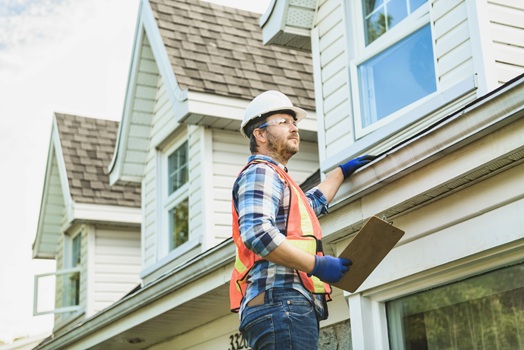
When summer temperatures start climbing, your roof takes the brunt of the heat. Most homeowners rarely consider how hot their rooftops actually get—until energy bills spike or signs of damage start appearing. A high-functioning roof does more than keep out the rain. It plays a crucial role in regulating your home’s temperature, especially when outdoor heat becomes relentless. This is where a thorough roof inspection comes in. It’s not just a check-up. It’s a preventive measure that helps keep your home cool, safe, and energy-efficient.
If your attic feels like a furnace or your AC is constantly running without relief, your roof may be contributing to the problem. Understanding how heat affects roofing materials and what you can do to improve cooling performance starts with knowing what’s happening up top.
Why Summer Heat Is a Silent Threat to Your Roof
Asphalt shingles, metal panels, and tile roofs all absorb heat, but the extent and impact vary depending on materials, age, and roof maintenance. On a sunny day, rooftop surfaces can easily reach over 160°F. That kind of heat doesn’t just sit on the surface—it transfers into your attic space, creating a domino effect on indoor temperatures.
Meanwhile, intense UV radiation breaks down roofing material over time. It causes cracking, blistering, fading, and eventually structural weaknesses. If you skip regular maintenance, you might not notice the damage until leaks appear, insulation deteriorates, or worse, mould forms from poor ventilation. A scheduled roof inspection is one of the simplest ways to identify early signs of heat-related stress and correct them before they become expensive repairs.
This blog is for homeowners concerned about keeping their homes cooler in summer without relying solely on air conditioning.
What Happens During a Roof Inspection and Why It Matters in Summer
A professional roof inspection in Greenville SC typically covers:
- Shingle condition and granule loss
- Signs of warping or thermal expansion
- Flashing and seal integrity
- Ventilation efficiency
- Underlayment status
- Gutter and drainage system checks
Roofing contractor in Greenville SC
In summer, these areas become even more important. For instance, poor attic ventilation doesn’t just shorten the lifespan of your roof—it traps heat that makes upper rooms feel like ovens. During a roof inspection in Greenville SC, a qualified technician can identify areas where airflow is restricted and suggest improvements such as ridge vents, attic fans, or soffit adjustments.
Thermal shock is another issue often overlooked. This refers to the rapid expansion and contraction of roofing materials caused by the intense heat of the day followed by cool nighttime temperatures. Over time, this cycle weakens fasteners, opens gaps between panels, and encourages leaks. An inspector can spot these subtle shifts early, saving you from major structural repairs later.
Choosing Materials That Stay Cool
So, if your roof is due for roof replacement or you’re building a new home, this is the perfect time to consider cool roofing materials. These are designed to reflect sunlight instead of absorbing it, significantly reducing rooftop temperatures.
Some of the most effective cool roofing options include:
- Light-colored asphalt shingles with solar-reflective granules
- Standing seam metal roofs with reflective coatings
- Clay or concrete tiles that allow air circulation under the surface
- Thermoplastic membranes for flat roofs
While these materials come with higher upfront costs, they often pay for themselves through reduced energy consumption and longer roof life. That’s why any quality roof inspection should include material recommendations tailored to your climate and home design.
Ventilation Makes or Breaks Cooling Performance
A hot roof in Greenville SC is one issue, but when that heat gets trapped inside your attic, it creates a bigger problem. Proper ventilation keeps air circulating, allowing heat to escape and preventing moisture buildup that can lead to rot, mildew, or sagging roof decks.
During an inspection, a roofing contractor will evaluate:
- Intake vents (usually in the soffits)
- Exhaust vents (like ridge vents or gable vents)
- Insulation coverage and condition
- Signs of condensation or water staining
If adjustments are needed, making these upgrades can lower attic temperatures by up to 30°F during peak summer months. That’s a noticeable difference not just for your roof, but for your overall indoor comfort and energy efficiency.
Simple Upgrades After Roof Inspection
You don’t always need to replace the entire roof to improve cooling. Sometimes, a post-inspection action plan may include:
- Adding a radiant barrier in the attic to reflect heat
- Installing cool roof coatings to improve reflectivity
- Sealing small leaks or gaps where hot air escapes into your living space
- Cleaning out clogged gutters to improve water flow and reduce pooling damage
Each of these can be tackled individually, or combined for a comprehensive cooling strategy. But it all starts with knowing where the weak spots are, and that’s what a summer roof inspection is meant to uncover.
KM Roof and Home Repair provides reliable insight and hands-on experience to ensure your roof inspection meets both performance and safety standards.
Our team understands how local weather patterns, roofing materials, and home layouts interact. Whether your goal is to extend the life of your current roof or prepare for a more energy-efficient upgrade, we help you prioritise the most impactful steps without overspending.
Call KM Roof and Home Repair now to schedule your roof inspection and learn how to protect your home from heat, cut cooling costs, and keep your roof performing at its best—summer after summer.
Like our Facebook page for more great info about roofing services.
KM Roof and Home Repair
Greenville, SC 29609
864-990-3252
www.kmroofers.com
Areas we serve: Piedmont SC, Fountain Inn SC, Simpsonville SC, Greer SC, Taylors SC, Greenville SC, Travelers Rest SC

No comments:
Post a Comment